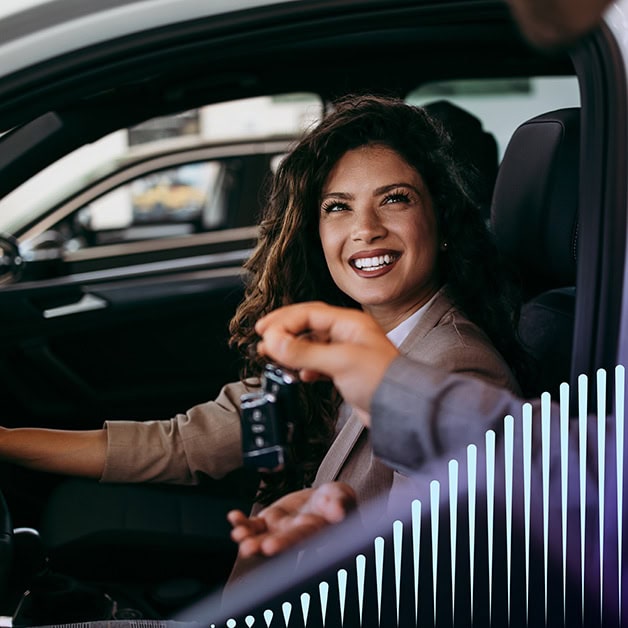People often throw around the term “hyper-local” without truly understanding what it means.
Many companies will refer to their scope of work as hyper-local when, in reality, it’s just local.
It goes without saying that before you can master hyper-local marketing, you need to know what it means. Let’s start with the basics.
This guide will explore everything you need to know about hyper-local marketing, including what it is, why it matters, and how you can get your hyper-local marketing strategy off the ground.
What is hyper-local marketing?
Hyper-local marketing leverages one-to-one customer targeting at the household or device level. This process requires affiliates to put intensive effort into strategic customization and optimization to effectively target prospects within the desired geographic locations.
For example, have you ever searched “restaurants near me” on your phone? Hyper-local marketing is what puts those recommendations at the top of your search results.
What’s the difference between hyper-local and local marketing?
Local refers to anything from Designated Market Area (DMA)- to zip-code-level marketing. So, local marketing is pretty focused compared to national and regional marketing, but it fails to target specific locations or individuals — that’s hyper-local turf.
To put into perspective just how granular hyper-local marketing is, let’s delve into the differentiators between each level of marketing:
- National: This level encompasses 1-100 campaigns targeting customer profiles all over the country.
- Regional: Regional marketing ranges from 1-100 campaigns per region targeting countrywide customer profiles with regional variances.
- Local: Local marketing scales hundreds of campaigns targeting countrywide customer profiles with regional variances at the DMA, city, or zip code level.
- Hyper-local: Hyper-local marketing spans thousands of campaigns targeting individual customers and households.
Why market at the hyper-local level?
So, hyper-local marketing gets pretty in the weeds… Isn’t that a lot of work?
We won’t sugarcoat it — hyper-local marketing is a lot of work. It involves an extremely customized approach that requires a lot of planning and attention to detail. But it’s also a highly valuable tactic that is absolutely worth the effort.
Here are the main benefits of hyper-local marketing:
- Increasing visibility: Hyper-local marketing puts your business on the map — literally. Businesses that rank for location-based searches are more visible to consumers in their areas.
- Boosting awareness: Hyper-local marketing helps drive greater awareness within your community, making your business more recognizable. That means if a consumer’s looking for a product or service you sell, your business will be top of mind for them.
- Driving conversions: Because hyper-local marketing is highly targeted, it puts your name in front of purchase-ready customers who are actively searching for products and services like yours, leading to a greater chance they’ll convert.
- Increasing foot traffic: Better search rankings and online conversions aren’t the only things you can expect from hyper-local marketing — brick-and-mortar stores also benefit from increased foot traffic and in-store sales.
- Achieving a high ROI: Because hyper-local “near me” searches have high purchase intent, you can expect to get the most out of your marketing investment.
- Improving customer loyalty: Due to the tailored nature of hyper-local marketing, you can cater more heavily to your customers’ needs, improving the customer experience and, subsequently, loyalty.
The 7 best hyper-local marketing strategies
Now that you understand the benefits of hyper-local marketing, it’s time to delve into the most effective strategies. Consider the following tactics when crafting your next hyper-local campaign.
1. Claim and optimize local listings
Your Google My Business listing is perhaps the most important instrument in your hyper-local toolbox. By claiming your listing, you ensure that Google suggests your business when nearby consumers search for products and services within your wheelhouse.
Keep in mind that a Google My Business listing isn’t the only one you can claim. You can also establish profiles on local directories and review sites like Yelp and MerchantCircle to increase your chances of getting in front of customers.
Here are some tips for customizing and maintaining your local business listings:
- Get detailed: Be sure to include as much information about your business as possible, including your name, address, phone number, store hours, web links, business categories, photos, and descriptions. The more details you add, the easier it’ll be for customers to find you.
- Be consistent: If you claim more than one listing for multiple locations or directories, it’s important that all your information is consistent across each listing.
- Stay up to date: If your business undergoes any changes, such as a new location, temporary closures, or changes in store hours, it’s vital that your listings are updated to reflect this information.
2. Use Google Ads
Google Ads are highly customizable pay-per-click (PPC) advertisements that allow you to target your desired geographic location. Here’s everything you need to do when creating your Google Ads campaign:
- Establish your radius: Specify the region or radius you want your ads to target. If you have multiple store locations, you can create different radiuses for each of them.
- Set up single-word ad groups: When you assign one hyper-specific keyword to each ad rather than using 20 sort-of-relevant keywords, your ads are more likely to convert.
- Include site extensions: Not all customers want to browse your website. Adding site extensions like addresses and phone numbers gives them other ways to contact you, making them more likely to reach out.
- Track performance: Tools like Google Tag Manager allow you to track ad conversions so you can see what’s working and what’s not.
3. Leverage paid ads on social media
Paid social media marketing is a great way to get your message to your target audience as they scroll through their favorite channels, such as Twitter, TikTok, and LinkedIn. However, Meta platforms like Facebook and Instagram are among the best paid ad platforms for hyper-local marketing, so we’d recommend these channels as a starting point.
Meta’s highly intuitive local awareness ads allow businesses to create highly targeted campaigns that boost awareness, then track their performance. You can create many types of ads through Meta’s ad managers, such as blogs, videos, and social media posts.
All you have to do is go to Meta Ads Manager, click “Create,” and choose a campaign objective. Are you looking to drive awareness, generate leads, or boost conversions? Specify this, then add your location radius and other demographic information like audience size and target demographic.
4. Use organic social media marketing
Leveraging hyper-local social media marketing is one of the easiest and most effective ways to connect with customers in your area — not to mention it’s totally free. And if you already have social media accounts for your business, you’re well on your way!
Be sure to add these tactics to your hyper-local social media marketing strategy:
- Use localization: You can utilize various localization options across social media platforms that enable you to tailor your content to specific areas, such as location tags, location hashtags, and profile locations.
- Keep your info updated: It’s important to stay on top of your profile information, keeping business and location information up to date.
- Stay active: It’s not enough to create social media accounts — you need to stay active on these pages to get the most brand awareness and engagement. You should post at least a few times a week and interact with your audience frequently to make the most of your platform.
5. Optimize for hyper-local SEO
One of the best ways to drive localized traffic to your website is to optimize your content for SEO. Search engine optimization (SEO) is the process of enhancing your web content to increase your website’s visibility in the search engine results pages (SERPs).
By creating helpful content that answers users’ search queries using locally relevant keywords, you can rank higher in the SERPs and increase lead generation and conversions.
Here are some tips for improving your hyper-local SEO:
- Use hyper-local keywords: When performing keyword research, choose hyper-local terms with relatively high search volume and low keyword difficulty for the best chance of ranking and generating traffic. Make sure to insert keywords into your body text, titles, subheads, alt text, URLs, and metadata.
- Create location pages: If you have multiple business locations, you should create custom landing pages for each of them. Make sure each web page features unique content and keywords.
- Use schema markup: Schema markup, or structured data, refers to information like ratings and reviews, news articles, and product information that search engines analyze to better understand your content. Implementing schema into your content helps Google rank it.
6. Generate and manage online reviews
Consumers value their peers’ opinions when purchasing products. In fact, 99.5% of consumers refer to product reviews when shopping online, and 93% say reviews impact whether they buy a product. In addition, reviews are an important search ranking factor on Google.
Encourage your customers to leave reviews after purchasing a product or service. As customers review your business, it’s vital to manage this feedback by responding to each comment. Show your customers you hear and appreciate them by thanking them for their business and feedback.
Got a negative review? These comments are most important to acknowledge. You should apologize for the poor experience and do what you can to resolve the problem. This shows your customers you’re amendable and truly care about their satisfaction. It also prevents unhappy customers from discouraging others from doing business with you.
7. Conduct offline advertising
Not all of your hyper-local marketing has to be online. In fact, it shouldn’t be. Offline advertising offers another effective means of increasing your business’s visibility within hyper-local markets.
Consider these offline tactics:
- Traditional marketing: Traditional marketing tactics like newspaper ads, radio, and out-of-home (OOH) advertising are tried-and-true ways to reach your hyper-local audience.
- Local events: Interacting with and supporting your community at local events is a great way to get them to support your business in return. Some of the most effective events tactics include hosting and exhibiting at events, sponsoring and advertising at events, and networking at local events.
- Print materials: Get creative with eye-catching print materials like flyers, point-of-sale displays, business cards, posters, and coupons.
Hyper-local marketing tips for business owners
As a local business owner, you have a lot on your plate. Running your business takes priority, which is why so many local businesses neglect their marketing efforts. However, there are things you can do to make your hyper-local marketing easier and more efficient.
Check out these hyper-local marketing tips to take the headache out of promoting your business.
Generate content with AI
AI is everywhere — and it’s making marketing easier. You can use marketing AI solutions to streamline your hyper-local marketing with minimal effort and maximum results.
Here are just a few of the many ways you can leverage AI in your marketing:
- Writing content: You can use generative AI to write content like blogs, emails, social media posts, and review responses in seconds.
- Automating tasks: AI-assisted workflows enable you to automate routine or repetitive tasks like managing funds, setting up campaigns, and ensuring compliance.
- Providing guidance: AI virtual marketing assistants can deliver personalized marketing recommendations to ensure you’re using the most impactful tactics.
Prioritize compliance
Marketing compliance is one of the most important aspects of any hyper-local marketing campaign. It ensures consistent messaging and accurate business representation while preventing consumers from being misled.
When you adhere to brand and legal compliance standards, you can improve the effectiveness of your marketing while reducing risks and ensuring you receive partner fund reimbursement.
Invest in social media services
Promoting your business and being active on social media can be time-consuming. That’s what social media programs are for:
- Self-serve: Access branded content, reporting, conversation monitoring, and article sharing easily.
- Do-it-for-me: Marketing experts will post on your behalf through do-it-for-me programs.
- Custom concierge: Get help responding to customers, executing influencer marketing, boosting organic posts, and more.
Take advantage of your partner marketing funds
If corporate provides you with partner marketing funds like co-op or market development funds (MDF), you should absolutely be taking advantage of them. After all, it’s basically free money! The only stipulation is that you must adhere to corporate’s pre-determined guidelines for approved marketing activities, claims submissions, and compliance. When you do these things right, you’ll draw even more customers to your business.
Use a local marketing platform
Local marketing platforms unite brands with their channel partners, providing marketing assets, tools, and resources under one centralized location and making hyper-local marketing a breeze.
With a complete suite of local marketing solutions, you can:
- Track performance: Marketing platforms enable you to easily measure your marketing efforts by providing you with valuable analytics and insights.
- Ensure marketing compliance: You can access brand-approved marketing materials and customizable templates to ensure your campaigns are always compliant.
- Simplify fund use: With a channel platform, you can easily access, track, and spend marketing funds on the best tactics.
Make Ansira your hyper-local marketing partner
Hyper-local marketing doesn’t have to be a hassle. Make it easy and drive results for your business with Ansira. We support over 1.6 million active users just like you, and we’re ready to add you to the list.
Book a demo of the industry-defining brand-to-local platform today.




